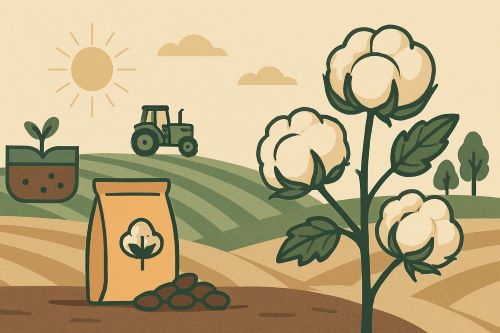


This blog explains the science behind hybrid cotton, how it’s produced, and what it means for farmers in terms of output, resilience, and investment.
Hybrid cotton seeds are produced by cross-pollinating two genetically distinct parent lines of cotton. This deliberate breeding results in a first-generation (F1) seed that carries the desired traits of both parents, such as disease resistance, faster growth, or superior lint yield.
The process follows these key steps:
Unlike open-pollinated varieties, hybrid cotton seeds cannot be saved and replanted year after year with the same result. Farmers need to purchase fresh hybrid seeds each season to ensure consistent performance.
The main reason farmers are switching to hybrid cotton is performance. When managed correctly, hybrid seeds typically outperform traditional varieties in yield and pest tolerance.
For example, Goldi-333 BGll Hybrid Cotton Seeds are known for their boll weight, high ginning percentage, and adaptability to water-stressed regions. Farmers using this variety have reported improved resistance to pink bollworm and uniform boll maturity across the field.
Hybrid seeds offer several field-level advantages:
No, but they can overlap. A hybrid seed is created through selective crossbreeding, while a GM seed is developed using biotechnology to insert specific genes.
However, many modern cotton hybrids now have GM traits like Bt genes (e.g., Cry1Ac, Cry2Ab) for bollworm resistance. These are called Bt cotton hybrids and represent a large percentage of commercial cotton in India.
Hybrid ≠ GM
But hybrid + GM = Enhanced performance under biotic stress
It’s essential to check whether the hybrid you’re buying has GM traits and ensure compliance with local agricultural laws.
Pest tolerance is one of the top selling points of cotton hybrids. Many carry built-in resistance to major cotton pests, reducing the need for chemical sprays.
Farmers using hybrid cotton often observe:
According to ICRISAT’s pest advisory, hybrid varieties with high canopy density must be monitored closely during peak humidity as this microclimate can attract whiteflies and mealybugs.
Hybrid cotton is renowned for its consistent yield, even in various environmental circumstances. Farmers in semi-arid areas or those who depend on unpredictable rainfall should pay particular attention.
Key contributing factors include:
“Seeds don’t just grow plants—they build futures. Choosing the right hybrid can define your harvest and shape your season.“
Hybrid cotton delivers its best results as part of a larger management plan. Farmers who succeed with hybrid seeds usually follow a set of innovative practices:
The whole potential of hybrid cotton can be realized by considering the seed as an investment rather than merely an input. Every growing season offers a chance to experiment, learn new skills, and adjust. Make informed decisions, practice intense management, and never stop asking what your crop is telling you. That is the start of true success.
